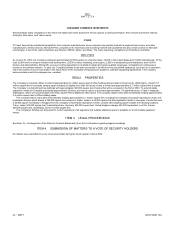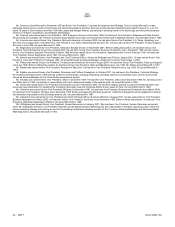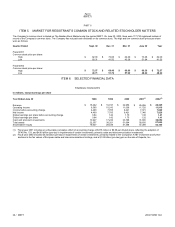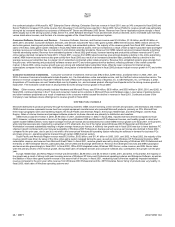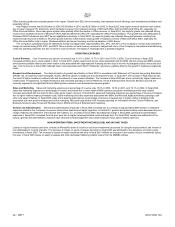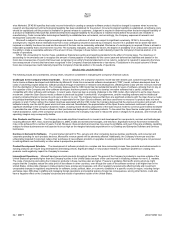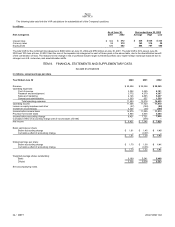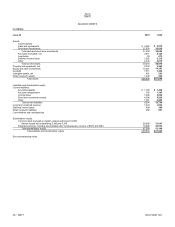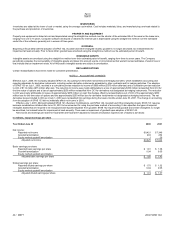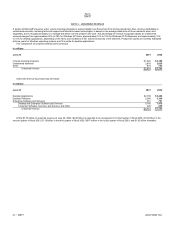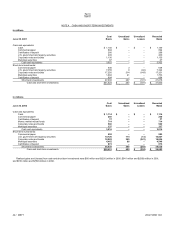Microsoft 2002 Annual Report Download - page 31
Download and view the complete annual report
Please find page 31 of the 2002 Microsoft annual report below. You can navigate through the pages in the report by either clicking on the pages listed below, or by using the keyword search tool below to find specific information within the annual report.
MSFT 33 / 2002 FORM 10-K
Part II
Item 7
Intellectual Property Rights. Microsoft diligently defends its intellectual property rights, but unlicensed copying and use of software represents a loss of
revenue to the Company. While this adversely affects U.S. revenue, revenue loss is even more significant outside the United States, particularly in countries
where laws are less protective of intellectual property rights. Throughout the world, Microsoft actively educates consumers on the benefits of licensing
genuine products and educates lawmakers on the advantages of a business climate where intellectual property rights are protected. However, continued
efforts may not affect revenue positively and further deterioration in compliance with existing legal protections or reductions in the legal protection for
intellectual property rights of software developers could adversely affect revenue.
Taxation of Extraterritorial Income. In August 2001, a World Trade Organization (“WTO”) dispute panel determined that the extraterritorial tax (“ETI”)
provisions of the FSC Repeal and Extraterritorial Income Exclusion Act of 2000 constitute an export subsidy prohibited by the WTO Agreement on Subsidies
and Countervailing Measures Agreement. The U.S. government appealed the panel’s decision and lost its appeal. On January 29, 2002, the WTO Dispute
Settlement Body adopted the Appellate Body report. President Bush has stated the U.S. will bring its tax laws into compliance with the WTO ruling, but the
Administration and Congress have not decided on a solution for this issue. In July 2002, Representative Bill Thomas, Chairman of the House Ways and
Means Committee, introduced the American Competitiveness and Corporate Accountability Act of 2002. If enacted, that bill would repeal the ETI regime and
introduce broad-based international reform. The proposed reforms would not materially affect the Company. On August 30, 2002, a WTO arbitration panel
determined that the European Union may impose up to $4.04 billion per year in countermeasures if the U.S. rules are not brought into compliance. The WTO
decision does not repeal the ETI tax benefit and it does not require the European Union to impose trade sanctions, so it is not possible to predict what impact
the WTO decision will have on future results pending final resolution of these matters. If the ETI exclusion is repealed and replacement legislation is not
enacted, the loss of tax benefit to the Company could be significant.
Litigation. As discussed in Note 19—Contingencies of the Notes to Financial Statements, the Company is subject to a variety of claims and lawsuits. While
the Company believes that none of the litigation matters in which the Company is currently involved will have a material adverse impact on the Company’s
financial position or results of operations, it is possible that one or more of these matters could be resolved in a manner that would ultimately have a material
adverse impact on the business of the Company, and could negatively impact its revenues and operating margins.
ITEM 7A. QUANTITATIVE AND QUALITATIVE DISCLOSURES ABOUT MARKET RISK
The Company is exposed to foreign currency, interest rate, and equity price risks. A portion of these risks is hedged, but fluctuations could impact the
Company’s results of operations and financial position. The Company hedges the exposure of accounts receivable and a portion of anticipated revenue to
foreign currency fluctuations, primarily with option contracts. The Company monitors its foreign currency exposures daily to maximize the overall
effectiveness of its foreign currency hedge positions. Principal currencies hedged include the Euro, Japanese yen, British pound, and Canadian dollar. Fixed
income securities are subject to interest rate risk. The portfolio is diversified and consists primarily of investment grade securities to minimize credit risk. The
Company routinely uses options to hedge its exposure to interest rate risk in the event of a catastrophic increase in interest rates. Many securities held in the
Company’s equity and other investments portfolio are subject to price risk. The Company uses options to hedge its price risk on certain highly volatile equity
securities.
The Company uses a value-at-risk (VAR) model to estimate and quantify its market risks. VAR is the expected loss, for a given confidence level, in fair
value of the Company’s portfolio due to adverse market movements over a defined time horizon. The VAR model is not intended to represent actual losses in
fair value, but is used as a risk estimation and management tool. The model used for currencies and equities is geometric Brownian motion, which allow
incorporation of optionality of these exposures. For interest rates, the mean reverting geometric Brownian motion is used to reflect the principle that fixed-
income securities prices over time revert to maturity value.
Value-at-risk is calculated by, first, simulating 10,000 market price paths over 20 days for equities, interest rates and foreign exchange rates, taking into
account historical correlations among the different rates and prices. Each resulting unique set of equities prices, interest rates, and foreign exchange rates is
applied to substantially all individual holdings to re-price each holding. The 250th worst performance (out of 10,000) represents the value-at-risk over 20 days
at the 97.5th percentile. Several risk factors are not captured in the model, including liquidity risk, operational risk, credit risk, and legal risk.
A substantial amount of the Company’s equity portfolio is held for strategic purposes. The Company attempts to hedge the value of these securities
through the use of derivative contracts such as collars. The Company has incurred substantial impairment charges related to certain of these securities in
fiscal 2002 and fiscal 2001. Such impairment charges have been incurred primarily for strategic equity holdings that the Company has not been able to
hedge. The VAR amounts disclosed below are not necessarily reflective of potential accounting losses, as they are used as a risk management tool and
reflect an estimate of potential reductions in fair value of the Company’s portfolio. Losses in fair value over a 20-day holding period can exceed the reported
VAR by significant amounts and can also accumulate over a longer time horizon than the 20-day holding period used in the VAR analysis.
The VAR numbers are shown separately for interest rate, currency, and equity risks. These VAR numbers include the underlying portfolio positions and
related hedges. Historical data is used to estimate VAR. Given reliance on historical data, VAR is most effective in estimating risk exposures in markets in
which there are no fundamental changes or shifts in market conditions. An inherent limitation in VAR is that the distribution of past changes in market risk
factors may not produce accurate predictions of future market risk.


